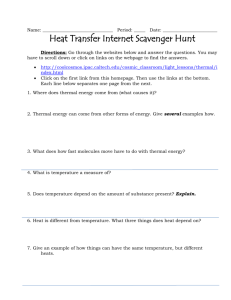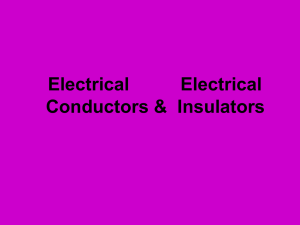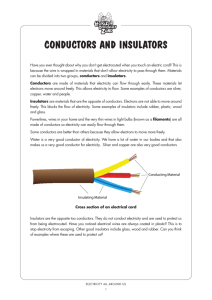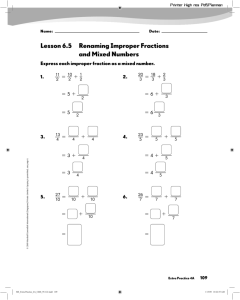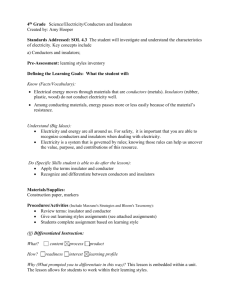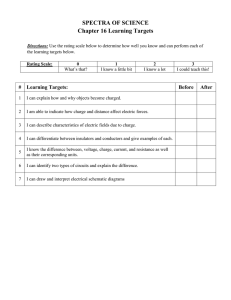Conductors and Insulators
advertisement
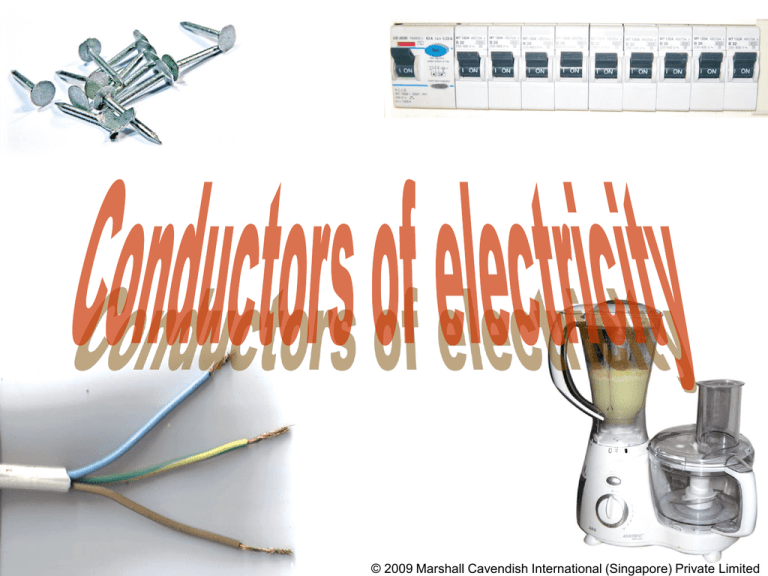
My Pals are Here! Science © 2008 Marshall Cavendish (Singapore) Private Limited © 2009 Marshall Cavendish International Questions to think about… What are electrical conductors and insulators? Are good conductors of electricity also good conductors of heat? How do we use electricity safely? © 2009 Marshall Cavendish International (Singapore) Private Limited What is electricity? • Electricity is conducted through some things better than others do. • Some materials are very resistant. Their atoms hold their electrons very tightly so they cannot move very well. These things are called insulators. (Can you give some examples?) • E.g. rubber, plastic, cloth, glass, dry air etc. • Some materials have loosely held electrons which move through them very easily. These are called • Conductors e.g. most metals like copper, aluminium, steel etc. Conductors and insulators • Take a close look at this wire. • There is metal on the inside and plastic on the outside. • Why? © 2009 Marshall Cavendish International (Singapore) Private Limited Conductors and insulators • Some materials, like copper, allow an electric current to flow through them. • Such materials are called conductors of electricity. • Many other metals also conduct electricity well. • Hence, wires are usually made of metals. © 2009 Marshall Cavendish International (Singapore) Private Limited Conductors and insulators • Examples of metals that are conductors of electricity: o aluminium © 2009 Marshall Cavendish International (Singapore) Private Limited Conductors and insulators • Examples of metals that are conductors of electricity: o iron © 2009 Marshall Cavendish International (Singapore) Private Limited Conductors and insulators • Examples of metals that are conductors of electricity: o copper © 2009 Marshall Cavendish International (Singapore) Private Limited Conductors and insulators • Examples of metals that are conductors of electricity: o gold © 2009 Marshall Cavendish International (Singapore) Private Limited Conductors and insulators • Examples of metals that are conductors of electricity: o silver © 2009 Marshall Cavendish International (Singapore) Private Limited Conductors and insulators • To prevent the electric current from flowing out of a circuit, wires are coated with plastic. • Plastic does not allow an electric current to flow through it. plastic © 2009 Marshall Cavendish International (Singapore) Private Limited Conductors and insulators • Other than plastic, many other materials do not allow an electric current to flow through them. • These materials are called nonconductors of electricity. • Non-conductors of electricity are also called insulators. © 2009 Marshall Cavendish International (Singapore) Private Limited Conductors and insulators • Examples of non-conductors of electricity: o paper © 2009 Marshall Cavendish International (Singapore) Private Limited Conductors and insulators • Examples of non-conductors of electricity: o rubber © 2009 Marshall Cavendish International (Singapore) Private Limited Conductors and insulators • Examples of non-conductors of electricity: o wood © 2009 Marshall Cavendish International (Singapore) Private Limited Conductors and insulators • Examples of non-conductors of electricity: o glass © 2009 Marshall Cavendish International (Singapore) Private Limited Conductors and insulators • Examples of non-conductors of electricity: o clay © 2009 Marshall Cavendish International (Singapore) Private Limited Using electricity safely • Electricity is useful but it can harm us if we do not use it carefully. • Other than getting a nasty shock, we can cause a fire if we do not use electricity carefully. So what can we do to protect ourselves? © 2009 Marshall Cavendish International (Singapore) Private Limited Using electricity safely • Never try to repair any electrical equipment or electrical socket yourself. • Get an adult or an electrician who knows how to repair it. © 2009 Marshall Cavendish International (Singapore) Private Limited Using electricity safely • When repairing any electrical equipment, proper tools with plastic or wooden handles should be used. • Such materials are nonconductors of electricity. • They prevent electricity from flowing from the equipment to our hands. © 2009 Marshall Cavendish International (Singapore) Private Limited Using electricity safely • Ensure that there are no exposed wires in electrical equipment. © 2009 Marshall Cavendish International (Singapore) Private Limited Using electricity safely • Never touch switches or electrical equipment with wet hands. © 2009 Marshall Cavendish International (Singapore) Private Limited Using electricity safely • Do not put too many plugs into one socket. © 2009 Marshall Cavendish International (Singapore) Private Limited Using electricity safely • Use safety devices such as circuit breakers and fuses. • Sometimes, fires are accidentally caused when too much current flows through a circuit. • Circuit breakers and fuses break a circuit when too much current flows through them. circuit breaker fuse © 2009 Marshall Cavendish International (Singapore) Private Limited My Pals are Here! Science © 2008 Marshall Cavendish (Singapore) Private Limited © 2009 Marshall Cavendish International
